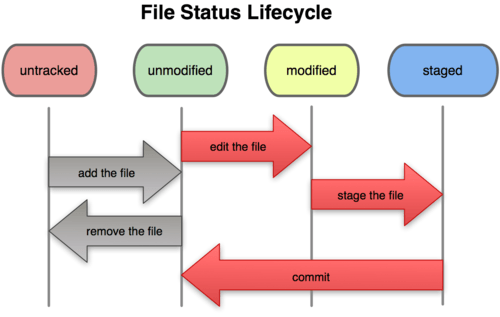Local Git Repo
A git repo is represented by a directory, just like any project. All your files will go in a directory. Try creating a directory with the following files:
- project_git
- readme.md
Once you're done, we can start on the first git command.
git init - Creating a local git repo
Inside the folder, you'll want to run the following command.
git init
This command will initialize a git repo, which actually creates a hidden folder that stores all the changes made to the project.
You'll only need to do this once per project. If you're cloning a git repo, this step is already taken care of for you.
git status - Checking your repo status
git status
Think of git status as your dashboard. The command will show you everything you need to know about the current state of your git repo, from untracked files to any outstanding changes that need to be made.
Currently, there are no commits, so we'll want to put files under the management of git. It'll involve two steps, adding and committing. These steps are very different.
git add - Adding files and directories
You can add files individually or the entire directory, including subfolders.
git add readme.md
git add .
The second command will add everything in the current working directory. But try running git status again. While the git add command adds these file changes, they're not actually saved. Think of this as the "staging" area of files where we decide what to permanently save and what to discard. Another good way to think of this is in baseball terms. This staging area is the "on-deck circle", getting things ready before batting.
git commit - Saving staged files
Let's say you're happy with your work and want to save a version. This is called committing:
git commit
This should open your editor. Save the screen you see and it should put you back into the terminal.
Now, the changes are permanently saved. The file now has a unique version in git and can be recovered if lost. Make sure everything is clean by running git status again.
Process for making changes
File status
Try making changes to the readme.md file. See what happens when you run:
git status
git diff - file differences
How do we find out what changed?
git diff readme.md
Stage and save
When we're ready to save those changes
git add readme.md
git commit
git checkout - checkout changes
Or, we can undo changes. If changes have been made before comitting, we can run checkout to reset the file back to its most recent commit state.
git checkout readme.md
git log - review commit history
Note that once you make a commit, you won't be able to unmodify those files. You can see a list of your commits by running:
git log
git rm - untrack a file
If a file has been added to git and it needs to be deleted, we can run git rm and commit the change.
git rm <file>
git add -u
git commit
Summary
git addfiles that become part of your program (track)git status <file>or.to see which files changed.git diffto see exactly what changed (by line)git commitfile changes to save (commit)git checkoutto dicsard local changes (unmodifiy)git rmto untrack files (remove)
This is the most simple workflow, things get a bit more complex when you start sharing code and manage larger code bases. But this is a good start.
IMPORTANT NOTE: Avoid creating git repositories inside other git repositories.
Git Best Practices
- NEVER use
git add . - ALWAYS add files explicitly. If you have multiple files, use full paths to
refer to each. Example:
git add foo/bar.md baz/qux.js - NEVER use
git commit -m "an example commit message" - ALWAYS use
git statusbefore any other command - NO commit is too small
- NO commit message is too long
- NEVER nest repositories
Additional Resources
- Git Commands Cheatsheet
- Learn Version Control with Git
- Visualizing Git Commands
- Github Git Cheat Sheet
Exercise
Create a new repo:
cd ~/code
mkdir git-intro
cd git-intro
git init
Check the status of the repo you just created:
git status
Now start creating your file:
sublime index.html
When sublime opens, paste this text in:
<!DOCTYPE html>
<html>
<head>
<title></title>
</head>
<body>
<h1>banana</h1>
</body>
</html>
Add this new file: git add index.html
Check the current status of your repo:
git status
Commit it: git commit
See the log of the file so far: git log
Add a second line:
<h2>kumquat</h2>
See what changes you made:
git diff
See the file status:
git status
Commit your changes:
git commit
Let's make some new changes: Take out the h1. Change kumquat to mango.
Commit as above.
Do git log to see a record of your changes.
Further
Add another HTML file to the repo. Make more changes to index.html as you like. Use diff status and add with specific file paths. e.g.: git diff index.html
Further
How do you unstage a file after you add it, but before you commit it? Google for the solution.
Further
How do you get back an earlier version of your code? Google for the solution.
